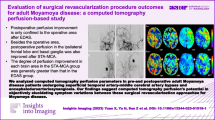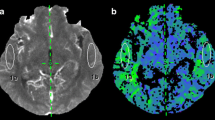Abstract
Object
Microsurgical anastomosis from the superficial temporal artery (STA) to the middle cerebral artery (MCA) is a treatment option for appropriately selected patients with cranial atherosclerotic steno-occlusive disease (CASD). However, the long-term efficacy and patency of the donor artery remain unclear. We reviewed the signal intensity of the donor artery on magnetic resonance angiography (MRA) after STA-MCA anastomosis in patients with CASD and clarified the incidence of and risk factors for reduction in postoperative signal of STA.
Methods
From April 2007 to March 2015, 155 STA-MCA anastomosis operations for CASD were performed at our institute. The postoperative imaging findings of 112 patients with available follow-up data for more than 3 months were retrospectively reviewed.
Results
Over a median follow-up of 24 months, the signal of the donor artery on MRA became weaker than that on MRA performed immediately after surgery in 30 (27%) patients. The rates of signal reduction at 1 and 2 years after surgery were 18 and 25%, respectively. Multivariate analysis revealed that a high STA bifurcation (p = 0.015; odds ratio, 7.14) and the presence of chronic kidney disease (p = 0.011; odds ratio, 5.59) were independent risk factors for postoperative signal reduction.
Conclusions
Our results suggest that the signal intensity of the donor artery of an established STA-MCA bypass decreases in many cases. Both the loose entrance of the STA to the dura and systemic atherosclerosis are related to postoperative vessel remodeling.





Similar content being viewed by others
References
Amin-Hanjani S, Shin JH, Zhao M, Du X, Charbel FT (2007) Evaluation of extracranial-intracranial bypass using quantitative magnetic resonance angiography. J Neurosurg 106:291–298
Eguchi T (2002) EC/IC bypass using a long-vein graft. Int Congr Ser 1247:421–435
Gonzalez NR, Liebeskind DS, Dusick JR, Mayor F, Saver J (2013) Intracranial arterial stenoses: current viewpoints, novel approaches, and surgical perspectives. Neurosurg Rev 36:175–184, discussion 184–185
Gorelick PB, Wong KS, Bae HJ, Pandey DK (2008) Large artery intracranial occlusive disease: a large worldwide burden but a relatively neglected frontier. Stroke 39:2396–2399
Gu Y, Ni W, Jiang H, Ning G, Xu B, Tian Y et al (2012) Efficacy of extracranial–intracranial revascularization for non-Moyamoya steno-occlusive cerebrovascular disease in a series of 66 patients. J Clin Neurosci 19:1408–1415
Ishishita Y, Kimura T, Morita A (2012) Urgent superficial temporal artery to middle cerebral artery bypass shortly after intravenous rt-PA. Br J Neurosurg 26:773–775
JET Study Group (2002) Japanese EC-IC Bypass Trial (JET Study): the second interim analysis. Surg Cereb Stroke 30:434–437
Low SW, Teo K, Lwin S, Yeo LL, Paliwal PR, Ahmad A et al (2015) Improvement in cerebral hemodynamic parameters and outcomes after superficial temporal artery-middle cerebral artery bypass in patients with severe stenoocclusive disease of the intracranial internal carotid or middle cerebral arteries. J Neurosurg 123:662–669
Matano F, Murai Y, Tateyama K, Tamaki T, Mizunari T, Matsukawa H et al (2016) Long-term patency of superficial temporal artery to middle cerebral artery bypass for cerebral atherosclerotic disease: factors determining the bypass patent. Neurosurg Rev 39:655–661
Mizumura S, Nakagawara J, Takahashi M, Kumita S, Cho K, Nakajo H (2004) Three-dimensional display in staging hemodynamic brain ischemia for JET study: objective evaluation using SEE analysis and 3D-SSP display. Ann Nucl Med 18:13–21
Nishimura K, Kimura T, Morita A (2012) Watertight dural closure constructed with DuraSealTM for bypass surgery. Neurol Med Chir (Tokyo) 52:521–524
Nuki Y, Matsumoto MM, Tsang E, Young WL, van Rooijen N, Kurihara C et al (2009) Roles of macrophages in flow-induced outward vascular remodeling. J Cereb Blood Flow Metab 29:495–503
Ota R, Kurihara C, Tsou TL, Young WL, Yeghiazarians Y, Chang M et al (2009) Roles of matrix metalloproteinases in flow-induced outward vascular remodeling. J Cereb Blood Flow Metab 29:1547–1558
Owens CD, Ho KJ, Kim S, Schanzer A, Lin J, Matros E et al (2007) Refinement of survival prediction in patients undergoing lower extremity bypass surgery: stratification by chronic kidney disease classification. J Vasc Surg 45:944–952
Powers WJ, Clarke WR, Grubb RL Jr, Videen TO, Adams HP Jr, Derdeyn CP et al (2011) Extracranial-intracranial bypass surgery for stroke prevention in hemodynamic cerebral ischemia: the Carotid Occlusion Surgery Study randomized trial. JAMA 306:1983–1992
Sia SF, Davidson AS, Assaad NN, Stoodley M, Morgan MK (2011) Comparative patency between intracranial arterial pedicle and vein bypass surgery. Neurosurgery 69:308–314
The EC/IC Bypass Study Group (1985) Failure of extracranial-intracranial arterial bypass to reduce the risk of ischemic stroke: results of an international randomized trial. N Engl J Med 313:1191–2000
Venermo M, Biancari F, Arvela E, Korhonen M, Soderstrom M, Halmesmaki K et al (2011) The role of chronic kidney disease as a predictor of outcome after revascularisation of the ulcerated diabetic foot. Diabetologia 54:2971–2977
Zhu FP, Zhang Y, Higurashi M, Xu B, Gu YX, Mao Y et al (2014) Haemodynamic analysis of vessel remodelling in STA-MCA bypass for Moyamoya disease and its impact on bypass patency. J Biomech 47:1800–1805
Author information
Authors and Affiliations
Corresponding author
Ethics declarations
Funding
No funding was received for this research.
Conflict of interest
None
Ethical approval
For this type of study formal consent is not required.
Previous presentations
None
Additional information
Comments
This manuscript examines the patency of the superficial temporal artery to the middle cerebral artery (STA-MCA) bypass performed in patients with cranial atherosclerotic steno-occlusive disease (CASD) using magnetic resonance angiography (MRA). The authors also examine the technical and clinical risk factors associated with bypass occlusion over time, and so it is an original work that adds to the literature. Interestingly, our group previously quantified STA-MCA bypass flows over time in CASD patients and found similar results: S Amin-Hanjani et al. Evaluation of extracranial-intracranial bypass using quantitative magnetic resonance angiography. J Neurosurg 2007;106:291–298.
Fady T. Charbel, Sophia F. Shakur
Chicago, IL, USA
Rights and permissions
About this article
Cite this article
Koizumi, S., Kimura, T. & Inoue, T. Signal reduction of donor artery on MRI after superficial temporal artery to middle cerebral artery anastomosis: a retrospective analysis. Acta Neurochir 159, 1679–1685 (2017). https://doi.org/10.1007/s00701-017-3128-x
Received:
Accepted:
Published:
Issue Date:
DOI: https://doi.org/10.1007/s00701-017-3128-x




